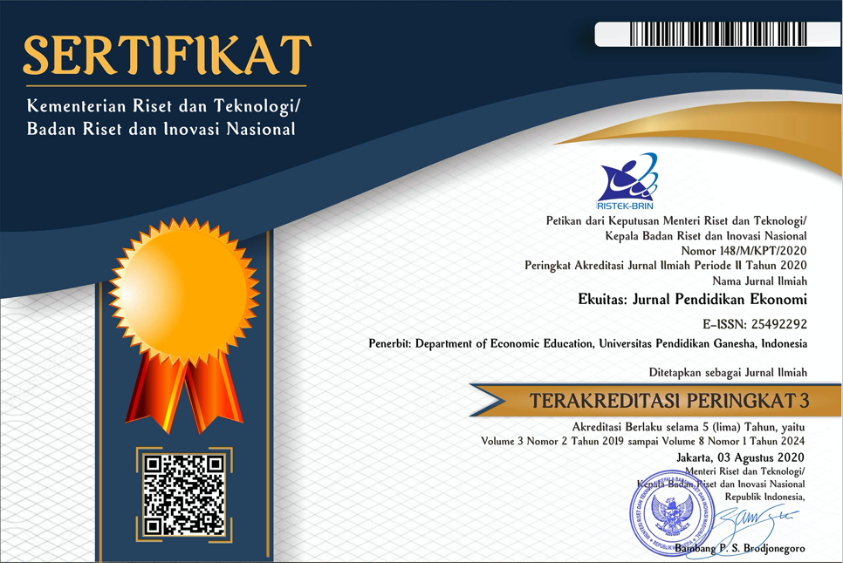Analisis Perbandingan PDB, Konsumsi, Investasi, dan Ekspor Neto di Indonesia Pada Era Presiden Susilo Bambang Yudhoyono dan Era Presiden Joko Widodo
DOI:
https://doi.org/10.23887/ekuitas.v8i2.29902Kata Kunci:
goverment policy, indonesian economy, president periodAbstrak
This research want to test economic condition betwen two president, Susilo Bambang Yudhoyono and Joko Widodo, on their fisrt period. GDP, comsumption, investation, and net export is become a variable in this economic calculations. Sample was taken from the first period of each periode president. With period of time 2005-2009, and 2015-2019. Time series data analysis using data from third parties, and test using independent sample t-test. The result of research found that the GDP, consumption, investation, and net export have a significant diference of each variable. Result of research an explanation that government work programs that focus on economic equity show an increase in GDP, consumption & investment. Meanwhile, the government work program that focuses on domestic stabilization shows that net exports have increased.
Referensi
Alan, S. B. (2014). Presidents and the U.S. Economy: An Econometric Exploration. Princeton university paper. pp. 1-63.
BPS. (2010). Produk Dosmetik Bruto Indonesia Triwulan 2005-2009’. https://www.bps.go.id/publication/2019/10/07/4923ba3ffd04cd25e83dcd97/pdb- indonesia-triwulanan-2015-2019.html. 23 Oktober 2020 (21:30)
BPS. (2020). Produk Dosmetik Bruto Indonesia Triwulan 2015-2019. https://www.bps.go.id/publication/2009/08/15/176e7a83ae816cd1e8de9bcd/produk- domestik-bruto-indonesia-triwulanan-2005-2009.html. 23 Oktober 2020 (21:25)
Capkova, S. & Rancakova, L. (2013). Fiscal Equalization and Regional Growth. European Scientific Institute, ESI, 2013. - 3 vol. (607, 337, 383 p.). pp. 376-384.
Coxhead, I. & Jayasuriya, S. (2010). China, India and the Commodity Boom: Economic and Environmental Implications for Low-income Countries. The World Economy (2010), 33(4). pp. 525-551.
Ergete, F. (2014). The Incentive Effects of Equalization Grants on Fiscal Policy. SPP Research Papers Volume 7 - Issue 23. pp 1-31.
Harisdiana. (2020). Berbagai Isu Ekonomi Mutakhir dan Strategi Pembangunan Ekonomi Tingkat Global Memasuki Awal Abad ke 21: Kajian Singkat Berbasis Survey Literatur tentang Gagasan dan Konsep dari Beberapa Ekonom Ternama Tingkat Dunia. Makalah. Universitas Padjadjaran. Bandung.
Hindriks, J. S, Peralta & Weber, S. (2008). Competing in Taxes and Investment Under Fiscal Equalization. Journal of Public Economics 92 (2008). pp. 2392–2402.
Kemenkeu. (2016). Media Keuangan: Langkah Taktis Paket Kebijakan Ekonomi. https://www.kemenkeu.go.id/media/4981/media-keuangan-juli_0.pdf. 23 Oktober 2020 (21:29).
Rahardja, P. & Mandala, M. (2008). Teori Ekonomi Makro, edisi keempat’. lembaga penerbit FE UI. Depok.
Sugiyono. 2015. ‘Metode Penelitian Pendidikan (Pendekatan
Kuantitatif, Kualitatif dan R&D). Penerbit CV. Alfabeta: Bandung.
Putriyanti, A. (2015). Kajian Undang-Undang Administrasi Pemerintahan dalam Kaitan dengan Pengadilan Tata Usaha Negara. Jurnal Pandecta Unnes Volume 10. Nomor 2. December 2015. hh. 180-194.
Wihardja, M. M. (2016). The Effect of the Commodity Boom on Indonesia’s Macroeconomic Fundamentals and Industrial Development. International Organisations Research Journal. Vol. 11. No 1 (2016). pp 39-54.
Windi, R. A. (2018). Analisis Efektivitas Kebijakan Moneter dan Kebijakan Fiskal terhadap Produk Domestik Bruto Indonesia. Economics Development Analysis Journal 7 (2) (2018). hh 194-202.








